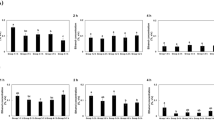Summary
Various in vitro experiments were performed for the purpose of clarifying the mechanism of ethanol production in corpses. Whereas a negligible quantity of ethanol was produced in the blood alone, which was left at room temperature, the quantity of ethanol was slightly increased by addition of glucose to the blood. When saprogens were further added, the quantity was markedly increased. Various materials were added to blood-liver homogenates as specimens, and the mixtures were stored in an incubator at 37°C. As a result of the addition of an antibiotic to the mixture every day, there was hardly any production of ethanol. When alcohol dehydrogenase (ADH) and reduced nicotinamide adenine dinucleotide (NADH) were added, ethanol production was slightly increased. When acetaldehyde was added first, ethanol production was inhibited the next day, but on and after day 2, the quantity of ethanol was more than that in the control material. When pyruvic acid was added first, the results were similar to the above. Pyrazole, cyanamide, and disulfiram completely inhibited the production of ethanol. Ethanol production in corpses is believed to take place through a pathway opposite to that of ethanol metabolism in the living body, under the influence of ADH, ALDH, etc., in saprogens using carbohydrates as substrates.
Zusammenfassung
Um den Mechanismus der Neubildung von Ethanol im Leichnam zu erhellen, wurden verschiedene Versuche unternommen. In Blutproben, gelagert bei Raumtemperatur, war nur eine unerhebliche Produktion von Ethanol nachweisbar, auch nach Zusatz von Glukose fand sich nur wenig Ethanol. Bei zusätzlicher Beimengung von Fäulnisbakterien war eine erhebliche Ethanolproduktion feststellbar. Zu Blut-Leberhomogenaten wurden verschiedene Stoffe zugesetzt und die Proben im Brutschrank bei 37°C aufbewahrt. Unter täglichem Zusatz eines Antibiotikums wurde Ethanol kaum produziert. Unter täglichem Zusatz von ADH und NADH nahm die Menge des produzierten Ethanols mäßig zu. Bei einmaliger Zugabe von Acetaldehyd wurde am ersten Tag die Produktion von Ethanol zurückgehalten, zeigte jedoch ab dem zweiten Tag fortlaufend höhere Werte als die Kontrollen. Ähnliche Ergebnisse fanden sich nach einmaligem Zusatz von Brenztraubensäure. Pyrazol, Cyanamid und Disulfiram verhinderten die Produktion von Ethanol völlig. Aufgrund der Befunde ist anzunehmen, daß die Produktion von Ethanol im Leichnam durch Stoffwechselvorgänge zustande kommt, die den beim Lebenden entgegenerichtet sind, wobei Enzyme wie ADH, A1DH etc. von Fäulniserregern mitwirken, die Kohlenhydrate als Stoffwechselsubstrat benützen.
Similar content being viewed by others
References
Gormson H (1954) Yeasts and the production of alcohol post mortem. J Forens Med 1:170–171
Machata G (1964) über die gaschromatographische Blutalkoholbestimmung. Analyse der Dampfphase. Mikrochim Acta 6:262–271
Mebs D, Schmidt K, Gerchow J (1978) Experimentelle Untersuchungen zur postmortalen Alkoholbildung. Blutalkohol 15:145–150
Mebs D, May M (1980) Weitere Studien zur postmortalen Alkoholbildung. Blutalkohol 17:207–213
Myer J, Leithoff H (1982) Untersuchung von Neubildung von Äthanol im Blut und Harn von Diabetikern. Blutalkohol 19:481–489
Nanikawa R, Ameno K, Okamoto S (1982) Medico-legal studies on alcohol detected in autopsied cases — Alcohol levels in stomach content. Jpn J Leg Med 36:329–334
Nanikawa R (1984) Medico-legal examination of alcohol in judicial autopsy cases and its practical significance. Res Pract Forens Med 27:199–208
Nanikawa R (1986) Leichenalkohol. Beitr Gerichtl Med 44:215–218
Osterhaus E, Johansmeier K (1966) Postmortale Entstehung von Alkoholen durch Fäulnis. Dtsch Z Ges Gerichtl Med 57:281–284
Weinig E, Schwerd W, Lautenbach L (1961) Die Neubildung von Äthanol, Methanol und anderen Alkoholen im Leichenblut und ihre forensische Bedeutung. Beitr Gerichtl Med 21:114–126
Author information
Authors and Affiliations
Rights and permissions
About this article
Cite this article
Nanikawa, R., Moriya, F. & Hashimoto, Y. Experimental studies on the mechanism of ethanol formation in corpses. Z Rechtsmed 101, 21–26 (1988). https://doi.org/10.1007/BF00205320
Received:
Issue Date:
DOI: https://doi.org/10.1007/BF00205320




